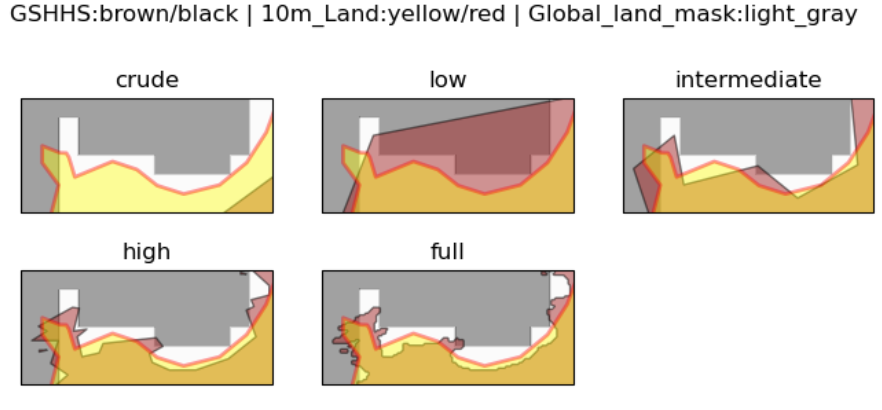如何将地球特征和陆地/海洋掩模应用于Cartopy的高分辨率海岸线?
如何将地球特征和陆地/海洋掩模应用于Cartopy的高分辨率海岸线?
提问于 2022-11-22 13:12:30
我在使用Cartopy中GSHHS数据集的海岸线。这对海岸线有很高的分辨率。但我不仅要绘制高分辨率的海岸线,而且要为海洋涂上一个面具。
import matplotlib.pyplot as plt
import cartopy
fig = plt.figure(figsize=(20,12))
ax = plt.axes(projection=cartopy.crs.PlateCarree())
coast = cartopy.feature.GSHHSFeature(scale="full")
ax.add_feature(coast, linewidth=2)
ax.add_feature(cartopy.feature.NaturalEarthFeature("physical", "land", "10m"))
ax.set_extent([-17, -16, 27.9, 28.7])执行代码时,图像有差异,因为我猜ax.add_feature(cartopy.feature.NaturalEarthFeature("physical", "land", "10m"))使用的是"10m“分辨率,而GSHHS具有更高的分辨率。

如何使用更高分辨率的GSHHS掩蔽?谢谢。
Stack Overflow用户
回答已采纳
发布于 2022-11-23 01:07:34
在回答how to apply a mask to hide features in the main plot问题之前,我们需要先调查一下可用的掩码。
在我们的例子中,main plot是Natural_Earth 10m解析物理域特性,GSHHSFeature的各种分辨率作为可用的掩码。
下面的代码和输出图显示了这种洞察力。
# Code adapted from:-
# Src: https://ctroupin.github.io/posts/2019-09-02-fine-coast/
import matplotlib.pyplot as plt
import cartopy
import cartopy.crs as ccrs
import cartopy.feature as cfeature
resolutions = {"c": "crude",
"l": "low",
"i": "intermediate",
"h": "high",
"f": "full"}
coordinates = (8.7, 8.81, 42.55, 42.60)
myproj = ccrs.PlateCarree()
fig = plt.figure(figsize=(8, 4))
for i, res in enumerate(resolutions):
ax = plt.subplot(2, 3, i+1, projection=myproj)
coast = cfeature.GSHHSFeature(scale=res)
ax.add_feature(coast, facecolor="lightgray")
ax.add_feature(cartopy.feature.NaturalEarthFeature("physical", "land", "10m"),
ec="red", fc="yellow", lw=2, alpha=0.4)
ax.set_xlim(coordinates[0], coordinates[1])
ax.set_ylim(coordinates[2], coordinates[3])
plt.title(resolutions[res])
plt.suptitle("GSHHS: gray Versus 10m_Physical_Land: yellow/red")
plt.show()假设我们需要一个在这个缩放级别的情节。很明显,来自两个数据源的轮廓并不适合观众的眼睛。我们可以得出结论,所有可用的掩码都不适合目标地块。
但是,如果地块范围较宽,或规模较小,再加上一些制图技术,例如使用较厚的海岸线,就可以得到可接受的地块。这个过程是试错的方法.

Edit1
添加(遮罩)后,可以绘制更多的选项以供比较。
from global_land_mask import globe
import matplotlib.pyplot as plt
import cartopy.crs as ccrs
import cartopy.feature as cfeature
import numpy as np
# Extent of map in degrees
minlon,maxlon,minlat,maxlat = (8.7, 8.81, 42.55, 42.60)
# Lat/lon points to get for `global_land_mask` uses
# Finer than 500x250 has no improvement
lons = np.linspace(minlon,maxlon, 500)
lats = np.linspace(minlat,maxlat, 250)
# Make a grid
lon_grid, lat_grid = np.meshgrid(lons,lats)
# Get whether the points are on land.
z = globe.is_land(lat_grid, lon_grid)
# GSHHS ...
resolutions = {"c": "crude",
"l": "low",
"i": "intermediate",
"h": "high",
"f": "full"}
myproj = ccrs.PlateCarree()
fig = plt.figure(figsize=(8, 4))
for i, res in enumerate(resolutions):
ax = plt.subplot(2, 3, i+1, projection=myproj)
# GSHHSFeature
coast = cfeature.GSHHSFeature(scale=res)
ax.add_feature(coast, facecolor="brown", alpha=0.5)
# 10m physical_land
ax.add_feature(cfeature.NaturalEarthFeature("physical", "land", "10m"),
ec="red", fc="yellow", lw=2, alpha=0.4)
# Global_land_mask data is used to create fillcontour
# The fillcontour with proper (colormap, zorder, alpha) can be used as land `mask`
ax.contourf(lon_grid, lat_grid, z, cmap="Greys_r", alpha=0.4)
ax.set_xlim(minlon, maxlon)
ax.set_ylim(minlat, maxlat)
plt.title(resolutions[res])
plt.suptitle("GSHHS:brown/black | 10m_Land:yellow/red | Global_land_mask:light_gray")
plt.show()
# The best resolutuion from `Global_land_mask` is plotted in `lightgray` covering the sea areas

页面原文内容由Stack Overflow提供。腾讯云小微IT领域专用引擎提供翻译支持
原文链接:
https://stackoverflow.com/questions/74533204
复制相关文章
相似问题

